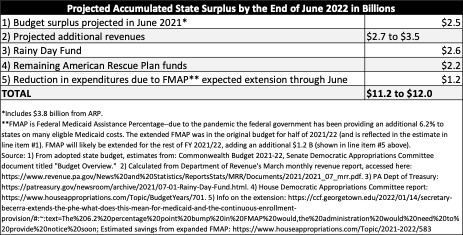Pennsylvania’s financial outlook for 2022/23 just got better. In March 2022, state revenues came in higher than expected as they have in nearly every month this fiscal year. Several months ago, we calculated that the state would have an estimated surplus of $10.7 billion at the end of 2021/22. Our revised estimate, after the Pennsylvania Department of Revenue’s March report, is that Pennsylvania will have a surplus of between $11.2 billion and $12 billion by the end of June 2022.
Fiscal year collections to date for 2021-22 total $2.7 billion, or 8.5% above estimates. If in the last quarter of this fiscal year, revenues come in according to the estimates of last June, the state budget surplus will be $2.7 billion greater than projected at the start of the fiscal year. If, however, revenues continue to come in at the rate of 8.5% above projections (and April is a big revenue collection month for Personal Income Tax), the state could end the fiscal year with $3.5 billion more than expected. (See #2 in table below.)
This means, alongside the budget surplus projected in June 2021, the state’s rainy day fund, the remaining American Rescue Plan funds, and extended Federal Medical Assistance Percentages (FMAP), the state of Pennsylvania’s financial outlook is better than it has been in recent history. And word on the street is that the federal government will again extend the national health emergency that raises the FMAP rate, saving Pennsylvania money into 2022/23. But the question remains: will Pennsylvania’s legislators use these funds to invest in the people of our state and address our ongoing public investment deficit, or will they continue to sit on it?
So far, the General Assembly has failed to even hold hearings on Governor Wolf’s Brighter PA plan to spend $1.7 billion of ARP funds to help Pennsylvanians deal with the economic stresses of our recovery from the pandemic, including inflation. Brighter PA calls for the state to provide opportunity grants that would give low- and middle-income families of four $700. The plan also calls for housing assistance, help for small businesses, and higher education loan forgiveness for health care workers.
We are also calling for the state to use this accumulated surplus to give $250 to the owner of every car and light truck in Pennsylvania to offset the temporary higher price of gas.
The funds are there. It’s time for the General Assembly to use them to help Pennsylvanians still struggling in an economy that is recovering with some difficulties from the pandemic.
